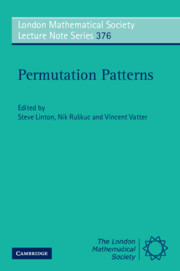Book contents
- Frontmatter
- Contents
- Preface
- Some general results in combinatorial enumeration
- A survey of simple permutations
- Permuting machines and permutation patterns
- On three different notions of monotone subsequences
- A survey on partially ordered patterns
- Generalized permutation patterns – a short survey
- An introduction to structural methods in permutation patterns
- Combinatorial properties of permutation tableaux
- Enumeration schemes for words avoiding permutations
- The lexicographic first occurrence of a I-II-III-pattern
- Enumeration of partitions by rises, levels and descents
- Restricted patience sorting and barred pattern avoidance
- Permutations with k-regular descent patterns
- Packing rates of measures and a conjecture for the packing density of 2413
- On the permutational power of token passing networks
- Problems and conjectures
- References
A survey on partially ordered patterns
Published online by Cambridge University Press: 05 October 2010
- Frontmatter
- Contents
- Preface
- Some general results in combinatorial enumeration
- A survey of simple permutations
- Permuting machines and permutation patterns
- On three different notions of monotone subsequences
- A survey on partially ordered patterns
- Generalized permutation patterns – a short survey
- An introduction to structural methods in permutation patterns
- Combinatorial properties of permutation tableaux
- Enumeration schemes for words avoiding permutations
- The lexicographic first occurrence of a I-II-III-pattern
- Enumeration of partitions by rises, levels and descents
- Restricted patience sorting and barred pattern avoidance
- Permutations with k-regular descent patterns
- Packing rates of measures and a conjecture for the packing density of 2413
- On the permutational power of token passing networks
- Problems and conjectures
- References
Summary
Abstract
The paper offers an overview over selected results in the literature on partially ordered patterns (POPs) in permutations, words and compositions. The POPs give rise in connection with co-unimodal patterns, peaks and valleys in permutations, Horse permutations, Catalan, Narayana, and Pell numbers, bi-colored set partitions, and other combinatorial objects.
Introduction
An occurrence of a pattern τ in a permutation π is defined as a subsequence in π (of the same length as τ) whose letters are in the same relative order as those in τ. For example, the permutation 31425 has three occurrences of the pattern 1-2-3, namely the subsequences 345, 145, and 125. Generalized permutation patterns (GPs) being introduced in allow the requirement that some adjacent letters in a pattern must also be adjacent in the permutation. We indicate this requirement by removing a dash in the corresponding place. Say, if pattern 2-31 occurs in a permutation π, then the letters in π that correspond to 3 and 1 are adjacent. For example, the permutation 516423 has only one occurrence of the pattern 2-31, namely the subword 564, whereas the pattern 2-3-1 occurs, in addition, in the subwords 562 and 563. Placing “[” on the left (resp., “]” on the right) next to a pattern p means the requirement that p must begin (resp., end) from the leftmost (resp., rightmost) letter.
- Type
- Chapter
- Information
- Permutation Patterns , pp. 115 - 136Publisher: Cambridge University PressPrint publication year: 2010



